Lithium iron phosphate (LFP) and ternary lithium (NMC) batteries are the two mainstream choices for electric vehicles and energy storage systems today. These two battery technologies have their own advantages, and which one to choose depends on your specific needs and usage scenarios. In the Chinese market, LFP currently accounts for 70% of the market share, while NMC accounts for 30%. Behind this data are technical and commercial considerations that are worth pondering.
Last updated: May 2025 | Estimated reading time: 12 minutes
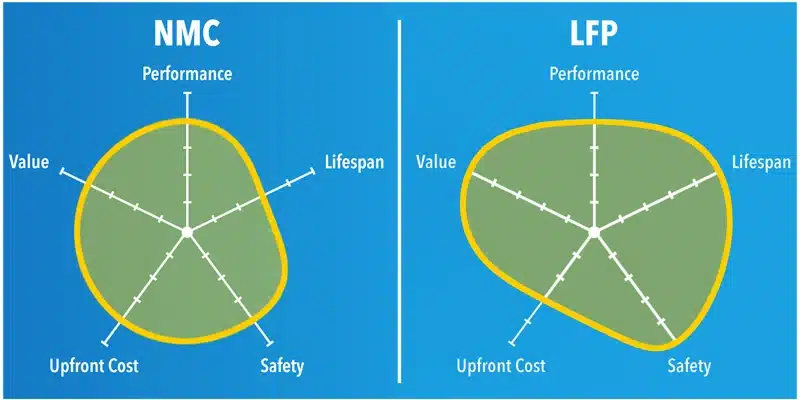
This article will answer your questions:
- What are LFP and NMC batteries, and how do their basic principles and structures differ?
- Which battery has better advantages in terms of safety, performance, cost and life?
- Which battery technology should be chosen for different usage environments (such as cold northern regions)?
- Why do high-end electric vehicles mostly use NMC, while economical electric vehicles tend to choose LFP?
- The latest battery technology trends in 2025 and their impact on your purchasing decisions
Table of Contents
ToggleWhat is LFP battery
LFP (lithium iron phosphate) battery is a lithium-ion battery with lithium iron phosphate as the positive electrode material, which is famous for its excellent safety, long cycle life and relatively low cost. In simple terms, it is like a highly stable “marathon runner” – reliable and long-lasting, but not the fastest.
LFP battery adopts olivine structure, in which the three-dimensional chemical bond formed by phosphorus-oxygen covalent bond gives it very strong thermodynamic and kinetic stability. This structure makes LFP battery stable even under high temperature conditions and not prone to thermal runaway, making it the preferred battery technology for many economical electric vehicles.
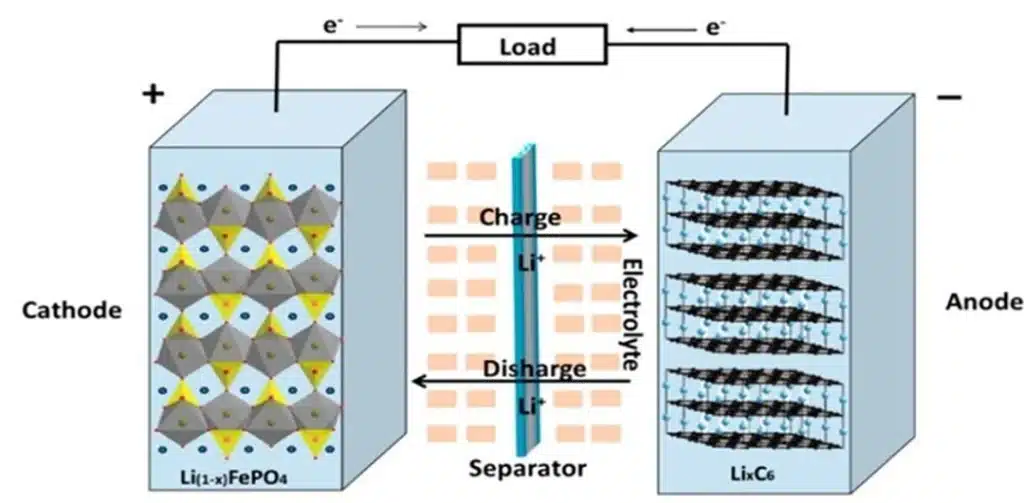
The operating voltage platform of lithium iron phosphate batteries is around 3.4V, a characteristic derived from the redox reaction of iron ions. Compared with lithium batteries commonly used in ordinary consumer electronics, LFP has the following unique advantages:
| Feature | Specific Parameter | Comparison to Traditional Lithium Batteries | Practical Implications |
|---|---|---|---|
| Cycle Life | 3000-5000 Cycles | 50-150% Higher | Electric vehicles can retain 80% battery capacity after 8-10 years of use |
| Safety | Thermal Runaway Temperature > 500°C | Significantly Higher | Extremely low risk of spontaneous combustion, providing greater peace of mind for home use |
| Raw Material Cost | Lower | Saves approximately 30-50% | More affordable vehicle purchase price, roughly 30,000-50,000 cheaper (currency not specified) |
What is NMC battery
NMC (nickel manganese cobalt) ternary lithium battery is a high-performance lithium battery with three metal oxides of nickel, manganese and cobalt as positive electrode materials. It is famous for its excellent energy density and low-temperature performance. Like a “sprint champion”, it provides stronger explosive power and higher performance ceiling, but has compromises in cost and safety.
The working principle of NMC battery is similar to that of LFP, but its charging and discharging process is single-phase solid diffusion without obvious phase interface. Therefore, the voltage curve is relatively steep, which facilitates accurate measurement of the state of charge and realizes more advanced battery management.
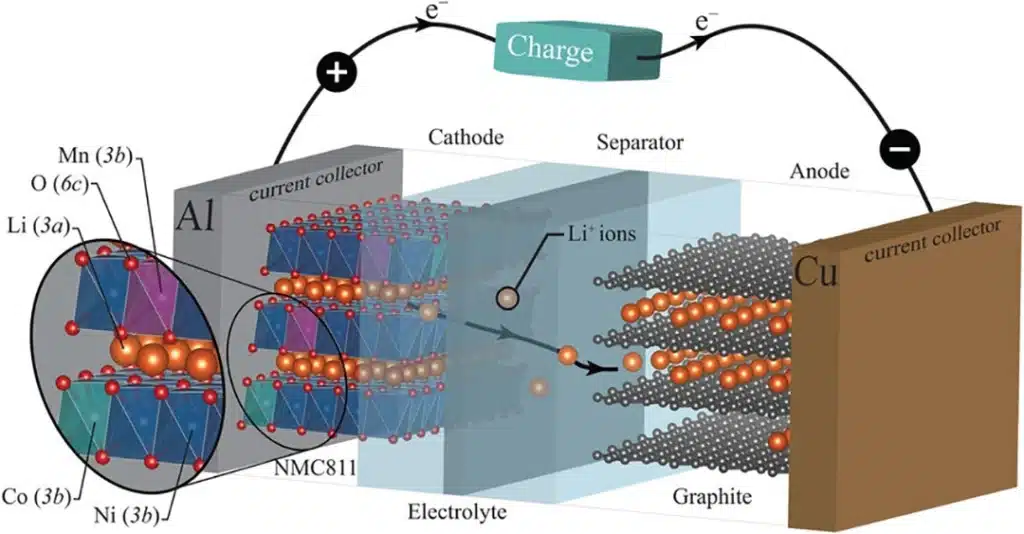
NMC batteries excel in energy density and low-temperature performance, which is why high-end electric car brands such as Tesla insist on using this technology in their long-range models:
| Feature | NMC Parameters | LFP Parameters | Practical Impact |
|---|---|---|---|
| Gravimetric Energy Density (Wh/kg) | 200-260 | 140-180 | 30-50% increase in range for the same weight |
| Volumetric Energy Density (Wh/L) | 500-700 | 300-400 | More interior space in the car, storage space is not affected |
| Low-Temperature Performance Degradation | Approximately 20% | Approximately 35% | Less reduction in driving range during winter |
Comprehensive comparison of 5 dimensions
To make an informed choice, we need to comprehensively compare the two battery technologies from multiple dimensions. The following is a comparative analysis of the five core dimensions based on the latest data in 2025.
Safety performance
In terms of battery safety, LFP batteries have obvious advantages, with better thermal stability and a thermal runaway temperature of over 500°C, while NMC is only around 200°C. This is like comparing the safety levels of fireproof materials – LFP inherently has a higher fireproof rating.
Professional laboratory research shows that when faced with the same thermal runaway conditions, LFP batteries mainly release smoke, with a heat release of 0.162 MJ at a rate of 1.81 kW; while NMC batteries will burn violently, releasing 3.147 MJ of heat at a rate of up to 134.85 kW – this means that the thermal hazard of NMC is about 70 times that of LFP.
However, it is worth noting that modern battery management system (BMS) technology has greatly improved the safety of NMC batteries. NMC battery packs of mainstream car companies are equipped with multiple protection systems, including:
- Cell-level protective measures (such as improved diaphragms and electrolytes).
- Module-level insulation and fire extinguishing system.
- Vehicle-level battery packaging armor and pressure relief valve.
In-depth comparison of performance parameters
In terms of pure performance, NMC batteries win with a clear advantage, with higher energy density, faster charging speed and better low-temperature performance. These advantages directly translate into longer driving range and better driving experience.
Considering the space constraints of the vehicle design, the difference in volumetric energy density is particularly critical:
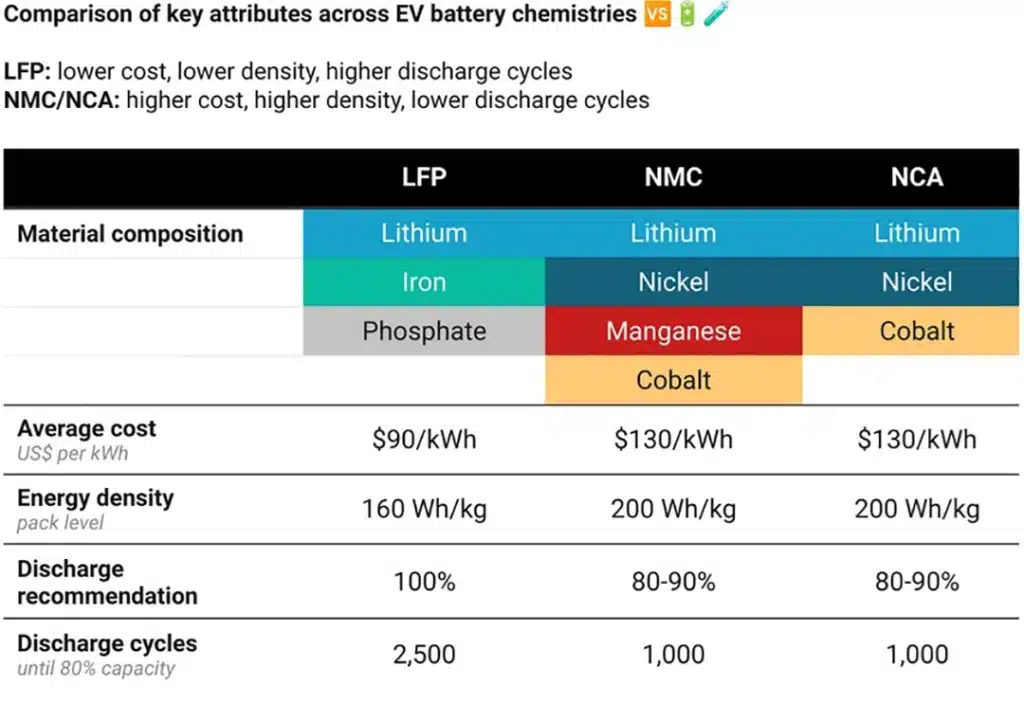
In actual driving experience, NMC battery models can usually provide:
- The cruising range is increased by 30-50% at the same weight
- Fast charging speed increased by 20-30% (charging time shortened by 10%-80%)
- In winter, the endurance loss is reduced by 10-15% in low temperature environment
Cost comparison
In terms of cost, LFP batteries have significant advantages, with raw material and production costs about 30-50% lower than NMC batteries. Taking a 60kWh battery pack as an example, the cost of LFP batteries is about 36,000 yuan, while the cost of NMC batteries of the same capacity is about 50,000 yuan.
This cost difference is directly reflected in the vehicle price. For example, for different battery versions of the same model, the LFP version is usually 30,000 to 50,000 yuan cheaper than the NMC version. For consumers with limited budgets, this is an important consideration.
But we also need to consider the full life cycle costs:
| Cost Factor | LFP Advantage | NMC Advantage | Impact on Consumers |
|---|---|---|---|
| Initial Purchase Cost | ✓ | LFP vehicles are 30,000-50,000 cheaper (currency unspecified) | |
| Battery Replacement Cost | ✓ | LFP replacement cost is 30-50% lower | |
| Fuel/Electricity Efficiency Comparison | ✓ | NMC has slightly higher energy efficiency; slightly lower charging costs | |
| Residual Value Retention | ✓ | LFP vehicles retain a higher percentage of their value on the used market |
Battery lifespan and durability
In terms of battery life, LFP batteries generally have longer cycle life and calendar life, which is one of its most significant advantages. The cycle life of LFP batteries is generally 3000-5000 times, while that of NMC batteries is about 2000 times.
However, this simple comparison can be misleading because:
- In actual use, LFP batteries need to be fully charged regularly to balance the cells, which will accelerate aging.
- NMC batteries can be used in the optimal range of 30%-80%, slowing down the aging process
- The level of sophistication of the battery management system also has a great impact on life.
Under the same conditions (such as 4,000 cycles from 75% to 65% of the power), the remaining capacity of both batteries can reach about 95%. In actual use, the life advantage of LFP batteries may not be as significant as the theoretical data.
Charge and discharge management and maintenance
In terms of daily convenience, NMC batteries perform better, and their active balancing technology does not require regular full charging, making them more flexible and free to use. This is an important advantage for users who cannot guarantee regular charging habits.
The voltage of LFP batteries changes very little in the range of 10%-95% power, making it difficult to accurately measure the power of a single cell, which results in:
- A full charge is required at least once a week to achieve cell balancing
- The battery level display may not be accurate enough, especially in the medium battery range
NMC batteries can:
- Accurately calculate the power of each battery cell through voltage and perform active balancing at any time
- Keep it in the optimal power range (30%-80%) to extend the life
- Provide more accurate range estimates
Practical application scenario analysis
After understanding the technical characteristics, let us combine it with actual application scenarios to help you make the choice that best suits your needs.
In the electric vehicle market, high-end models mainly use NMC batteries while economical models prefer LFP batteries. Behind this trend is a well-thought-out product positioning strategy. This distinction is not only based on cost considerations, but also on the differences in needs of different consumer groups.
Consumers who purchase low-end economy electric vehicles typically:
- More attention paid to the initial price of the vehicle
- Mostly used for short-distance commuting in cities
- Relatively low requirements for driving range
High-end electric car consumers:
- More emphasis on overall driving experience and performance
- More long-distance driving needs
- Willing to pay a premium for better technology
Market data in 2025 shows that among China’s electric vehicles priced below 200,000 yuan, LFP accounts for about 85%; and among models priced above 300,000 yuan, NMC accounts for about 70%. This market structure confirms the view that “the buyer is not as smart as the seller.”
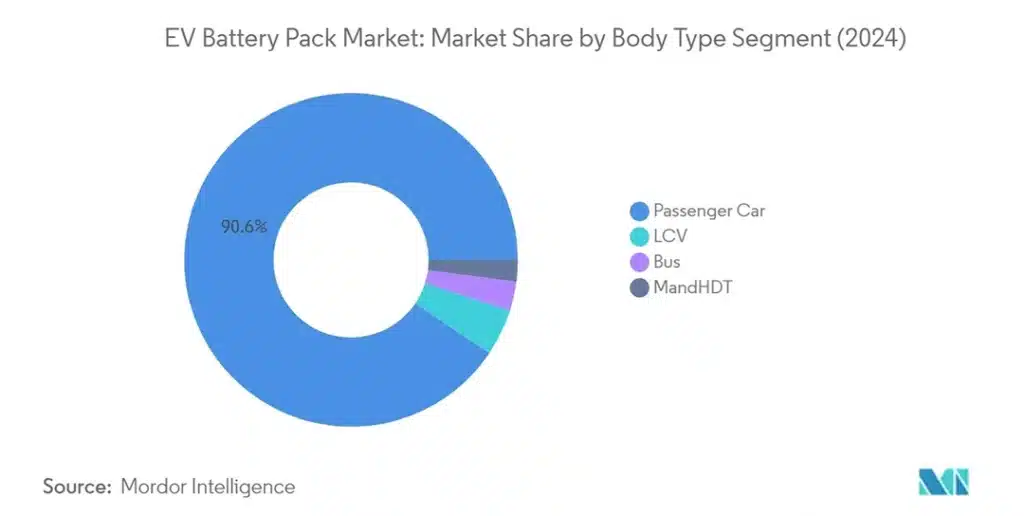
Regional and climate adaptability
Climate conditions have a significant impact on battery performance. Users in cold northern regions will have a better experience if they choose NMC batteries, while users in warm regions will not see much difference between the two technologies. This is because low temperatures have a more serious impact on LFP batteries.
| Climate Condition | Best Battery Choice | Main Reason | Real-World Impact |
|---|---|---|---|
| Northern Cold Regions (Below 0°C in Winter) | NMC | Better Low-Temperature Performance | Winter range reduction approximately 20% compared to 35% for LFP |
| Southern Warm Regions | Both Acceptable | Minimal Temperature Impact | No significant performance difference |
| High-Altitude Cold Regions | NMC | Combined Pressure & Temperature Effects | More stable range and charging speed due to resilience to pressure and temperature |
In a test in Heilongjiang Province, the NMC version of the same vehicle model still maintained about 65% of its rated endurance in a -20°C environment, while the LFP version could only maintain about 45%. This gap is particularly obvious in actual winter use.
Future technology development trends
Battery technology is advancing rapidly, and here are the latest technology trends and innovations through 2025 that may influence your purchasing decisions.
LiFePo4 battery technology is developing through three major paths: improving compaction density, manganese doping, and cell structure innovation. It is expected to narrow the energy density gap with NMC in the next three years. This means that the cost-effectiveness advantage of LFP will be further enhanced.
- Improved compaction density: The compaction density of modern LFP batteries has been increased from the traditional 2.4g/cm³ to 2.8g/cm³, close to 80% of the theoretical density (3.6g/cm³), which directly increases the volume energy density.
- Manganese doping technology: Manganese-iron co-doping technology allows the operating voltage of lithium iron phosphate batteries to be increased to 4.1V (traditionally 3.4V), and the energy density is increased by about 20% while maintaining good safety.
- Structural innovation: Through the optimization of the ratio of large and small particles and advanced carbon coating technology, the conductivity and ion diffusion rate of the new generation of LFP batteries are significantly improved, and the actual utilization rate is close to 90% of the theoretical capacity.
BYD Chief Scientist Lian Yubo once predicted that “lithium iron phosphate batteries will not be eliminated within 20 years”, and this view has gained more and more support in the industry. With the advancement of technology, the market competitiveness of LFP batteries will continue to increase.
NMC battery technology is developing towards high nickel and low cobalt, while strengthening safety design and reducing costs to maintain its leading position in the high-end market. The latest NMC technology in 2025 has achieved significant improvements in safety.
- High nickel and low cobalt: The latest NMC9.5.5 technology (nickel: cobalt: manganese = 9:0.5:0.5) significantly reduces the use of rare metal cobalt, while increasing the energy density to more than 300Wh/kg.
- Improved safety: New functional electrolyte additives and high-strength ceramic coating diaphragm technology have greatly improved the safety of NMC batteries, and the puncture test pass rate is close to the LFP level.
- Cost control: By optimizing production processes and supply chain management, the cost of NMC batteries has dropped by about 18% in the past two years, narrowing the price gap with LFP.
Actual tests show that the performance of the latest NMC batteries in 2025 in thermal runaway tests has been greatly improved. Although it is still not as good as LFP, the safety margin is sufficient to meet the needs of conventional usage scenarios.
Conclusion
There is no absolute “best” choice of electric vehicle battery technology, but it depends on your specific needs, budget and usage scenarios. Here is a concise decision guide to help you find the battery technology that best suits you:
Reasons to choose LFP battery:
- Limited budget: initial purchase cost is the primary consideration
- Safety first: extremely high requirements for battery safety
- Urban short-distance use: mainly used for daily commuting, not often long-distance driving
- Regular charging habits: fully charge at least once a week
- Warm climate areas: Living in the south or areas with higher temperatures year-round
Reasons for choosing NMC batteries:
- Range priority: longer single-charge driving range
- Frequent long-distance driving: Regularly driving long distances between cities or across provinces
- Cold Area Use: Living in the north or areas with low winter temperatures
- Inconvenient charging: Regular charging cannot be guaranteed, requiring a more flexible charging strategy
With the continuous advancement of technology, the gap between LFP and NMC is gradually narrowing. Before you choose or buy, you can check our comparison of lifepo4 battery and NMC battery products.
Hongyitai has been focusing on lithium-ion battery production for more than 10 years, helping customers in 100 countries and regions around the world to customize lithium-ion batteries. We provide both LFP and NMC battery products, and can provide professional selection suggestions and customized solutions based on customers’ specific application scenarios and needs.
